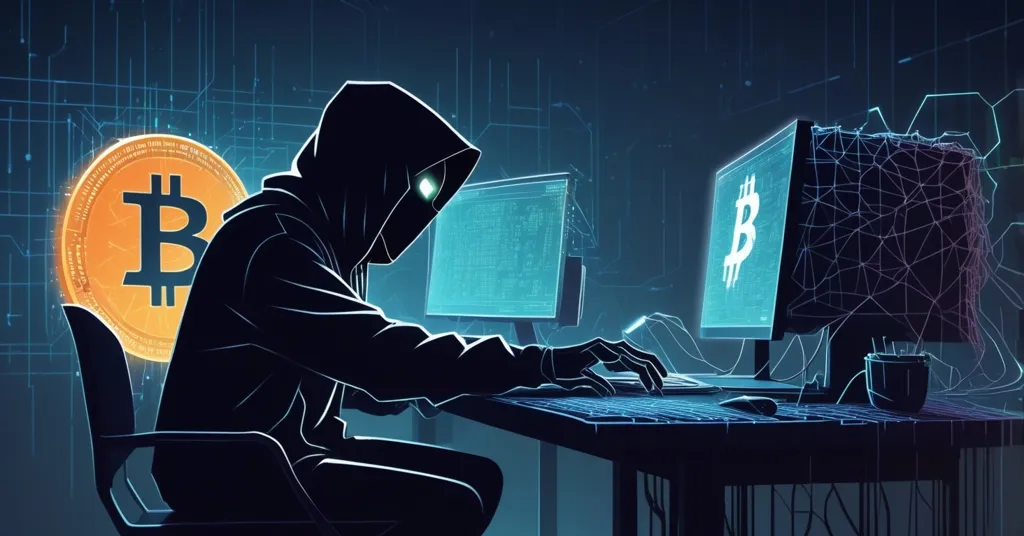Bipartisan AI Fraud Bill Targets Deepfakes: A Critical Threat to Crypto Trust

Bipartisan Bill Targets AI Fraud and Deepfakes: A Looming Threat to Crypto Trust
Picture this: a video surfaces online of a Bitcoin Core developer announcing a catastrophic bug, urging everyone to dump their holdings. Markets tank, panic spreads, and scammers rake in millions—only for the video to be revealed as a hyper-realistic AI deepfake. This nightmare scenario isn’t far off, and a new bipartisan bill in the U.S. is sounding the alarm on AI-driven fraud, aiming to curb deepfake attacks targeting federal officials and, by extension, protecting vulnerable spaces like cryptocurrency.
- Core Legislation: The AI Fraud Deterrence Act updates fraud laws to tackle AI scams and deepfakes.
- Heavy Penalties: Doubles fines to $2 million and criminalizes impersonating officials with AI.
- Crypto Risk: AI fraud poses direct threats to blockchain trust and market stability.
The AI Fraud Deterrence Act: Cracking Down on Digital Deception
Introduced by Representatives Ted Lieu (D-Calif.) and Neal Dunn (R-Fla.), the AI Fraud Deterrence Act is a bold move to modernize U.S. fraud laws for the age of artificial intelligence. The legislation, as detailed in a recent report on the bipartisan effort, specifically targets AI-driven scams, with a focus on deepfakes—fake audio or video content created by AI that’s often indistinguishable from reality. Its primary goal is to criminalize the impersonation of federal officials using such tech, a problem that hit headlines earlier this year with AI attempts to mimic White House Chief of Staff Susie Wiles and Secretary of State Marco Rubio.
Under the bill, penalties for AI-assisted fraud would double from $1 million to a staggering $2 million, sending a loud message to tech-savvy crooks. It also updates definitions of mail fraud (think traditional scams via postal services, punishable by up to 20 years in prison) and wire fraud (digital scams over email or internet, carrying up to 30 years) to explicitly include AI-mediated deception. These aren’t just numbers; they reflect a recognition that AI scams aren’t petty theft—they’re high-stakes crimes capable of undermining public trust on a massive scale. Compared to standard fraud penalties, these harsher measures underscore the unique danger of AI’s speed and realism.
Representative Neal Dunn emphasized the urgency of keeping pace with tech, stating:
“As AI technology advances at a rapid pace, our laws must keep up. The AI Fraud Deterrence Act strengthens penalties for crimes related to fraud committed with the help of AI. I am proud to co-lead this legislation to protect the identities of the public and prevent misuse of this innovative technology.”
Ted Lieu echoed this, highlighting public sentiment for oversight, noting that most Americans want “sensible guardrails on AI” rather than a free-for-all approach that risks chaos.
The Growing Threat of AI Deepfakes
Deepfake technology, powered by generative AI—a type of artificial intelligence that crafts new content like videos or voices based on learned patterns—has evolved from a quirky internet gimmick to a weapon for fraud. What used to be detectable through quirks like distorted hands or unnatural movements in fake videos is now nearly flawless, leaving old tricks for spotting fakes obsolete. Hany Farid, a UC Berkeley professor and co-founder of digital authentication firm GetReal Security, put it bluntly:
“AI years are dog years. You can’t look for hands or feet. None of that stuff works anymore.”
The FBI sounded the alarm in December, warning that generative AI slashes the effort criminals need to pull off convincing scams. Unlike a poorly worded phishing email that might raise red flags, AI can polish human errors, crafting fraud so slick it fools even the wary. The agency noted that this tech “reduces the time and effort criminals must expend to deceive their targets.” Meanwhile, Maura R. Grossman, a research professor at the University of Waterloo, highlighted the unprecedented magnitude of the problem:
“AI presents a scale, a scope, and a speed for fraud that is very, very different from frauds in the past.”
Real-world cases drive the point home. The deepfake attempts on Susie Wiles and Marco Rubio earlier this year, though specifics remain limited for security reasons, show how AI can target high-profile figures to sow confusion or extract sensitive info. The ripple effects are chilling: if a federal official can be impersonated, what stops scammers from faking a president’s voice to manipulate policy or public opinion?
AI Fraud’s Direct Threat to Bitcoin and Blockchain Trust
Now, let’s zoom in on the crypto space, where trust isn’t just important—it’s the bedrock. Unlike traditional finance, where banks act as middlemen, Bitcoin and blockchain rely on code, community consensus, and decentralized systems for security. A single fake announcement can shatter that fragile trust, and AI deepfakes are the perfect tool for such havoc. Imagine a deepfake of Vitalik Buterin claiming a critical Ethereum flaw, prompting mass sell-offs or disrupting staking pools. Or picture a fabricated SEC official “announcing” a Bitcoin ETF rejection, tanking prices overnight while scammers short the market. These aren’t wild hypotheticals; they’re the next wave of rug pulls and phishing hacks, supercharged by AI’s realism.
The crypto world is already a minefield of scams—think fake ICOs or Twitter accounts impersonating Elon Musk to peddle bogus tokens. Add AI into the mix, and the damage multiplies. A deepfake video of a DeFi project lead promoting a sham token sale could drain liquidity pools before anyone blinks. Bitcoin, with its massive market cap, isn’t immune either; a faked Satoshi Nakamoto message could spark chaos, even if the real Satoshi remains a mystery. Altcoins like Ethereum, with complex smart contracts, might face even higher risks of manipulation compared to Bitcoin’s leaner, more transparent design—though no chain is truly safe without countermeasures.
Can Blockchain and Decentralization Fight Back?
Here’s where the ethos of decentralization, a cornerstone of Bitcoin and crypto, offers a glimmer of hope. Blockchain technology, with its immutable public ledger, could be a shield against AI fraud. Imagine decentralized identity (DID) protocols—systems where users control their digital IDs on-chain—used to verify a video’s authenticity before it spreads. Bitcoin’s transparent transaction history could anchor trust in a way that centralized platforms can’t, while Ethereum’s smart contracts might automate verification triggers, flagging suspicious content tied to wallet addresses.
But there’s no free lunch. On-chain identity solutions raise privacy concerns; linking real-world identities to blockchain data clashes with the anonymity many in the crypto community cherish. Plus, altcoins with intricate systems might be more prone to bugs or exploits that AI scammers could target, unlike Bitcoin’s simpler architecture. Ultimately, while blockchain offers tools to combat deepfakes, adoption and standardization are far off. We’re in a race against scammers who are coding faster than regulators or devs can patch.
As champions of effective accelerationism, we argue the real fix isn’t just laws but accelerating decentralized tech to outrun fraudsters. Relying on slow, bureaucratic guardrails won’t cut it; we need innovation at warp speed—think open-source AI detection tools or NFT-based authenticity certificates—built by the crypto community, for the crypto community.
Challenges and Counterpoints: Regulation vs. Freedom
While the AI Fraud Deterrence Act is a necessary jab at rampant fraud, let’s play devil’s advocate. Could this bill, with its hefty penalties and labeling mandates, overreach into stifling legitimate tech? AI isn’t just a scammer’s toy; it’s fueling groundbreaking tools in blockchain analytics and DeFi optimization. Harsh laws might spook developers from experimenting, slowing the very innovation we crave. And what’s to stop this regulatory creep from targeting crypto next? Today it’s AI deepfakes; tomorrow, could a “misleading” Bitcoin tweet land you in hot water?
Balancing security with freedom is the tightrope. As Bitcoin maximalists, we see centralized oversight as a slippery slope—laws meant to protect can morph into tools of control, clashing with the spirit of decentralization. Yet, ignoring AI fraud isn’t an option; scammers thrive in unregulated gaps, and mass adoption of crypto hinges on trust. The bill also smartly carves out exemptions for satirical or non-malicious AI use, showing some restraint. Still, we must ask: will these measures keep pace with AI’s breakneck evolution, or are we just bolting the barn door after the horse has bolted?
Global Context and Future Outlook
The U.S. isn’t alone in grappling with AI fraud. Countries like the EU are rolling out frameworks like the AI Act, classifying high-risk AI systems with strict oversight, while China tightly controls deepfake tech to curb misinformation. Crypto markets, being global, will feel the ripple of uneven regulations—scammers could exploit lax jurisdictions to target Bitcoin or Ethereum holders worldwide. Looking ahead, the crypto space must adapt, perhaps by integrating cross-chain verification or lobbying for laws that protect without overstepping. The fight against AI fraud is just beginning, and blockchain’s role in it remains an open question.
Key Questions and Takeaways
- What does the AI Fraud Deterrence Act aim to achieve?
It seeks to modernize U.S. fraud laws by targeting AI-driven scams, doubling penalties to $2 million, criminalizing deepfake impersonations of federal officials, and mandating labeling of AI content with exemptions for non-malicious use. - Why is AI fraud such a pressing issue?
AI’s ability to craft hyper-realistic deepfakes at scale and speed makes scams nearly undetectable, threatening public trust, as warned by the FBI and experts like Maura R. Grossman. - How does AI fraud threaten Bitcoin and crypto markets?
Deepfakes could impersonate crypto leaders or officials to spread fake news, manipulate prices, or steal funds via sham token sales, exploiting the trust-based nature of decentralized systems. - Can blockchain technology counter AI fraud?
Potentially, through decentralized identity protocols and immutable ledgers like Bitcoin’s, but challenges like privacy trade-offs and slow adoption remain significant hurdles. - Is there a risk of overregulation with this bill?
Yes, harsh penalties and oversight could stifle AI and blockchain innovation or lead to centralized control, conflicting with crypto’s ethos of freedom and decentralization. - What’s the long-term solution for crypto’s safety?
Beyond laws, accelerating decentralized tech—such as open-source detection tools or on-chain verification—is key to outpacing scammers and preserving trust without heavy-handed regulation.
The AI Fraud Deterrence Act is a stark reminder that innovation’s dark side can’t be ignored. As we push for Bitcoin’s dominance and crypto’s mass adoption, we must grapple with threats like AI fraud that exploit trust gaps. This bill is a step toward protection, but it’s not the endgame. True security lies in the crypto community’s ability to innovate faster than the crooks—building decentralized defenses that render deepfakes powerless. Let’s not wait for lawmakers to catch up; the blockchain revolution depends on us staying one step ahead.


